On our recent trip to the Carolinas Claudia and I visited the southern section of the Blue Ridge Parkway, and what a treat that was.
Before our trip I asked my friend Charlie Cramer about the area, as I knew he’d spent some time there, and he told me he loved the southern stretch of the Blue Ridge Parkway, and pointed me toward some good areas for dogwoods. He also put me in touch with his friend Nye Simmons, author of Best of the Blue Ridge Parkway. Nye generously gave me some photography suggestions over the phone, as well as an advance copy of the Photographer’s Edition of Best of the Blue Ridge Parkway, which was a great resource. I’m not sure when this edition will be available, but I highly recommend it to photographers visiting the Blue Ridge Parkway, both for the information and the photographic inspiration. And for further inspiration, check out Nye’s beautiful coffee-table book, Blue Ridge Parkway Celebration (see a preview here, or order from Amazon here).
During our first day along the parkway, while scouting for our workshop, it was raining off and on, and at higher elevations the road climbed into the clouds, where we encountered thick fog. It was interesting to stop at some of the viewpoints the parkway is famous for and not be able to see more than 50 feet. But I loved it, because interesting weather makes interesting photographs, and I relished the opportunity to photograph trees in the fog.
We soon encountered our first sarvis trees (also known as serviceberry). I’d never heard of these trees before Nye mentioned them, but they quickly became a favorite subject. Most of the other trees were bare at the higher elevations, but the sarvis were in full bloom, adding splashes of white and pale pink to the hillsides. They were particularly abundant around the Graveyard Fields area, where I got to photograph them in fog on that first day.
Later that day the sun started to break through the clouds. We stopped at a view of Looking Glass Rock, where I got out my camera to photograph the dappled light, and a rainbow appeared right in front of the rock (the photograph at the top of this post).
We spent the night at the Mount Pisgah Inn, with its fabulous views. The next morning dawned clear, and I drove about five miles to the Pounding Mill Overlook. I could see some fog in the valleys below, but a bank of clouds to the east blocked the earliest light, so it turned into a nice, but not spectacular, sunrise.
There were two other photographers there, and one of them expressed some disappointment about the sunrise and then left. Soon afterward the sun broke over the cloud bank and lit up the fog in the valley below. I used my 70-200mm zoom to photograph patterns of backlit mist and trees, and made some of my favorite images of the trip.
To me this was a great lesson in how expectations can be a photographer’s enemy. The photographer I met was hoping for something particular, didn’t get it, and left disappointed. I had never been to this spot before, and didn’t have any particular expectations, so I was open to whatever opportunities I found. There’s always something to photograph if you can drop your preconceptions and see what’s in front of you.
When we returned a few days later with our workshop group we photographed sarvis again at Graveyard Fields, this time with beautiful, late-afternoon backlight. The next day one of the students, who is intimately familiar with the parkway, led us to an area near the road that was carpeted with wildflowers. Now these carpets weren’t like the dense mats of poppies and other flowers that can be found in California, but rather a forest understory with many beautiful medium-to-small-scale scenes of leaf patterns and blossoms. I photographed some false hellebore leaves (see the photograph below) – a close relative of corn lilies, a common summer plant in Sierra Nevada meadows.
Our time along the parkway was all too brief, but we loved it up there, so we’ll just have to go back. It would be great to visit in the fall, or later in the spring when the rhododendrons are blooming. Then again, I’d be happy to return in early May to photograph sarvis again.
There are a few waterfalls along the parkway, but many more lower down, and we had a great time photographing some of them. But I’ll save those photographs for the next post…
– Michael Frye
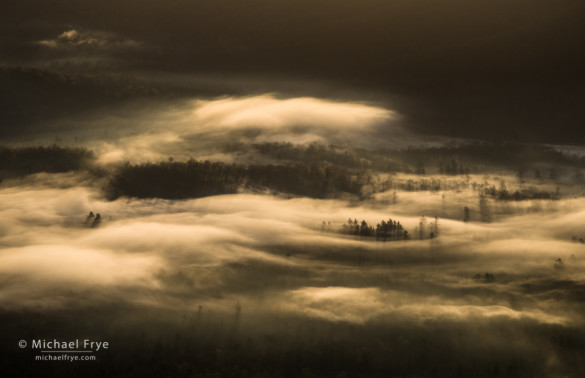
Trees in fog after sunrise from the Pounding Mill Overlook, Blue Ridge Parkway, NC, 7:06 a.m., May 1st
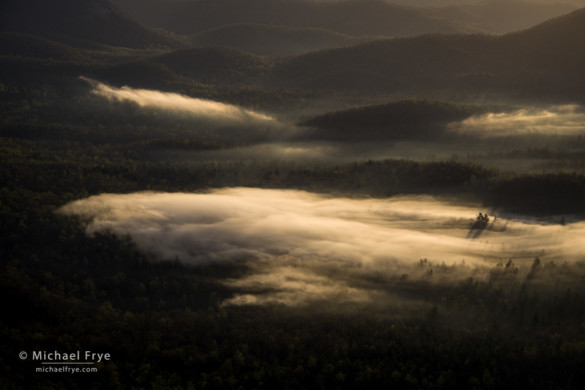
Trees in fog after sunrise from the Pounding Mill Overlook, Blue Ridge Parkway, NC, 7:09 a.m., May 1st
Related Posts: Back From the Southern Appalachians; A Trip to South Carolina
Did you like this article? Click here to subscribe to this blog and get every new post delivered right to your inbox!
Michael Frye is a professional photographer specializing in landscapes and nature. He is the author or principal photographer of The Photographer’s Guide to Yosemite, Yosemite Meditations, Yosemite Meditations for Women, and Digital Landscape Photography: In the Footsteps of Ansel Adams and the Great Masters. He has also written three eBooks: Light & Land: Landscapes in the Digital Darkroom, Exposure for Outdoor Photography, and Landscapes in Lightroom 5: The Essential Step-by-Step Guide. Michael written numerous magazine articles on the art and technique of photography, and his images have been published in over thirty countries around the world. Michael has lived either in or near Yosemite National Park since 1983, currently residing just outside the park in Mariposa, California.

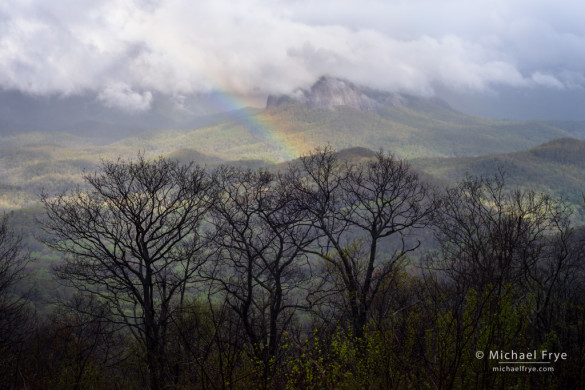
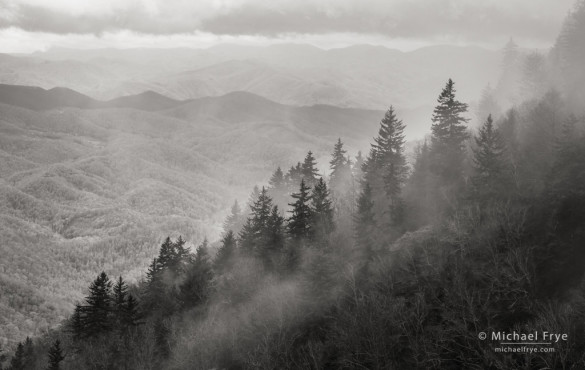
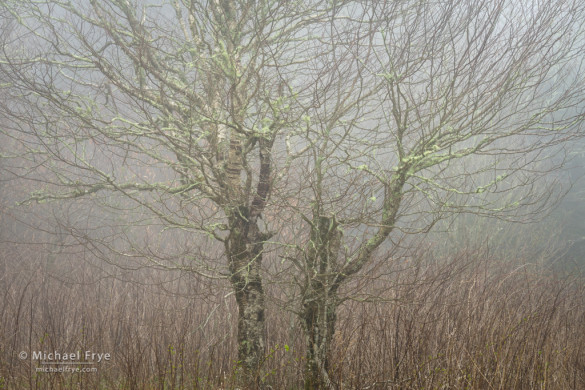
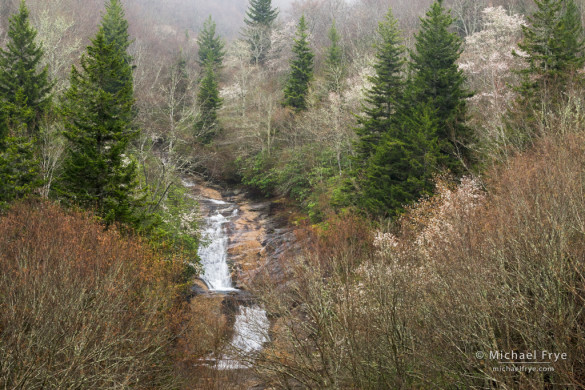
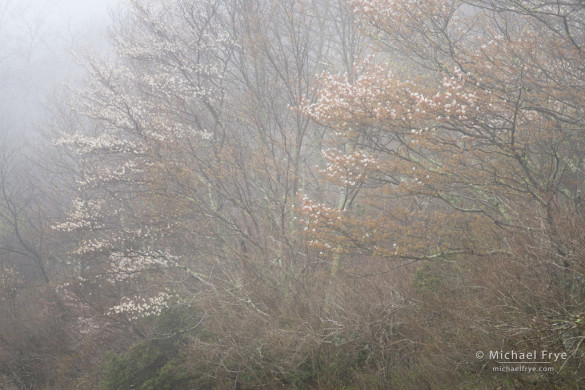
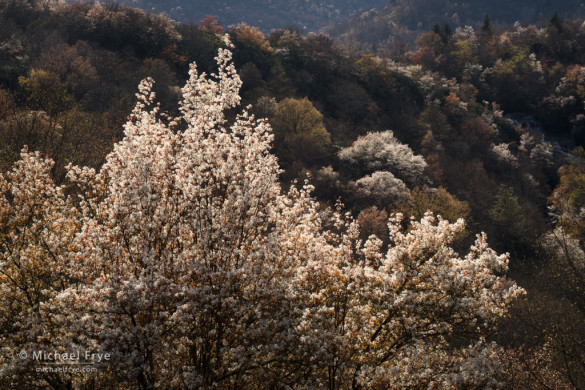
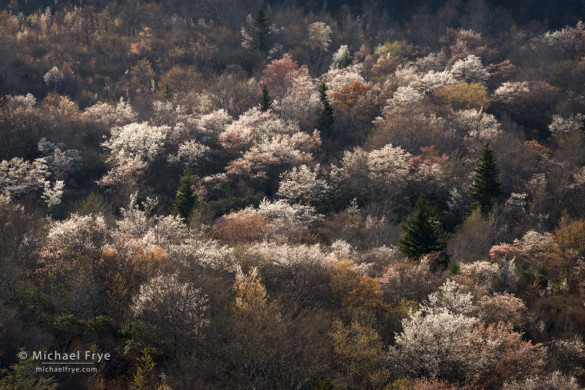
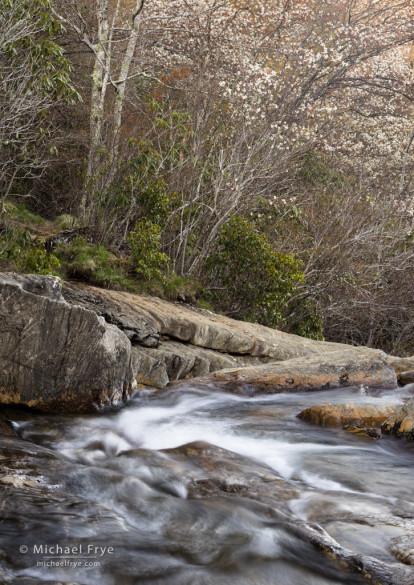

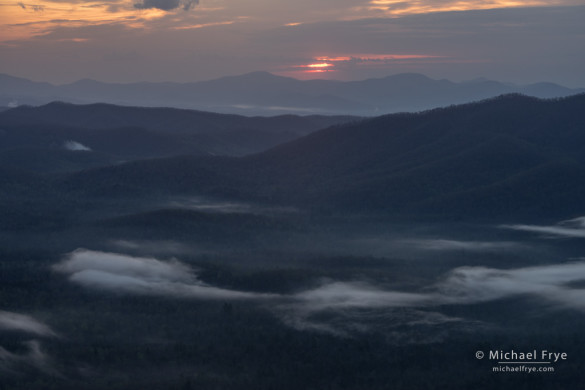








Great post and wonderful photographs! I hope to be able to visit the Parkway someday. And that morning fog image is a real stunner – a great example of letting go of expectations. [and the importance of patience] Looking forward to those waterfalls in your next post!
Thanks very much F. Henexson!
Michael,
This is a wonderful set of photographs. Impressive to get so many nice ones on a first visit. (Well, I’ve never been there; maybe everyone would be so lucky?) Thanks for posting the clock times on the series of sunrise shots – just goes to show you, that the patient bird sometimes gets the worm, not just the early ones.
– Marke
P.S. – Rhododendrons and Calla lilies are still in bloom on the Mendocino coast, as well as iris and lupines, and there seem to be lots of poppies around my Sonoma County home turf this year. I wonder how the Antelope Valley Poppy Preserve was/is doing?
Thanks very much Marke. I did get lucky with some of the weather. And thanks for theh info about the Mendocino coast. I’m sure Antelope Valley poppies are long gone; I never much about them this year.
Michael,
I think you captured fantastic images based on what Mother Nature presented to you on this trip. Your point about expectations is well taken and thus freed you up for beautiful possibilities.
I enjoyed this whole new view of stunning landscapes and textures, so different than what we are familiar (and spoiled?) with in the West.
A visit during the Fall season is something I have always wanted to do. Thanks again for sharing your journey and talents.
Thank you Ann! It is a very different landscape than the west. Not as dramatic, but beautiful in a more subtle way. If you like trees, as I do, it’s a great place. 🙂
The hillside dotted with Sarvis (Graveyard Fields 2)) is one of my favorites of the post–a nice impression of the color and light of spring there. Thank you for the story about photographing in the moment. I find it hard to abandon expectations of a place I know as well–even when I think I am, like during the last snow storm in Yosemite Valley when excitement over the scene gave way to an apprehension about missing the photos, so I panicked and lost my focus. During my first snowstorm there my excitement lead to many great photos. I would appreciate any tips you might have for dealing with panic during a fleeting photo opportunity.
Thanks very much Gery – glad you like that photo. Your question about panicking is a good one, as it happens to many people when presented with an exciting photo opportunity. I started my career as a wildlife photographer, and in hindsight that was good training for many things, including this. I missed a lot of wildlife photos because I got too excited about a rare opportunity, and forgot to pay attention to things like composition and focus. What cured me of this was the painful memory of missing those photos. In other words, the next time it happened, I remembered that I had to concentrate on executing the photo, and I did – or at least I got better at it.
Unfortunately I don’t know any easy way to get over that sense of panic other than painful experience. It helps to take a deep breath – if you can remember to do that. I think it also helps to do things step by step, and not try to get ahead of yourself. Sometimes, for example, I see workshop students thinking about exposure before they’ve found a composition, and you can’t make any decisions about exposure until you know what’s going to be in the frame. So develop a routine that you go through for every photograph, practice it, and stick with it when things get exciting. For me, the routine is as follows (assuming it’s a landscape photo and the camera is on a tripod):
1. Compose
2. Add and adjust filters if necessary
3. Focus
4. Set the aperture (based on the depth of field needed)
5. Set the exposure by setting the shutter speed (in manual mode) or exposure compensation (in aperture priority)
6. Take the photo with the 2-second self timer or cable release
7. Check the histogram and blinkies and adjust the shutter speed or exposure compensation if necessary
8. Zoom in on the photo just taken and check sharpness
I hope that helps.
Thank you for your very helpful, and good orderly direction. I do forget to breathe at times, especially at sunrise. I will practice more near home so that reacting in early light become second nature when the stakes are higher on the road.
As a native southeasterner, it’s great to see a post filled with beautiful images from you on the Blue Ridge Parkway! Try to make it back for fall sometime – the third weekend of October is usually the best bet for peak leaves along the Parkway. I don’t think any place surpasses the Parkway in fall, although many places may rival it.
So true what you say about expectations and getting impatient. One of my favorite photos of all time took place on a day when I didn’t pull my camera out once and nearly packed it in to go back to the hotel. It was late October on the Parkway in the higher elevations of NC. Most of the leaves had dropped and it was an ugly, hazy day. Everything seemed to be cast in shades of grey and brown. But something about the clouds in the western sky told me to give sunset a shot if I could find a good west facing overlook. Finding a good west facing overlook in the NC portion of the Parkway is much easier said than done! Finally I found one about 2 hours before sunset, got set up, and then sat and waited it out. It ended up being the most brilliant mountain sunset I’ve ever had the privilege of photographing and the only really good picture from that trip.
Thanks Blake, and I would like to make it back in fall sometime, though I’m usually doing a workshop in the eastern Sierra the third week of October. And thanks also for your story about the sunset photo – I’m glad that worked out!
It’s fun to see your work from different places (as much as I love seeing Yosemite)! The trees in fog near Waterrock Knob really grabbed me for the strong diagonal lines and that wonderful fog. I also liked the wider version of the sarvis in bloom – such a nice patchwork of blooming trees, the lines and curves on the false hellebore (the insect is an added bonus), and then all the views from above, looking down at the low lying fog.
Thanks very much Vivienne! I appreciate the kind words, and I’m glad you like the images.
Beautiful set of images. I am especially drawn to the hellebore leaves. Gorgeous image!
Thank you Robyn!
Wonderful set of images, Michael!! A destination for your return trip to the Southeast in autumn is Pinnacle Overlook in the Cumberland Gap National Historical Park, overlooking where Kentucky, Tennessee and Virginia meet. It’s worthy of anybody’s bucket list, I believe.
Jeremy, thanks for the kind words and the suggestion!
Minnehaha Falls is in Minnesota, if you Google Minnehaha Falls it will guide you to Minnesota, I have many pictures of Minnehaha Falls. The Location in your pictures is no where close to Minnesota, Just an observation…
But some great pictures…
Richard, try Googling “Minnehaha Falls Georgia.” 🙂 There are apparently at least two waterfalls with this name.